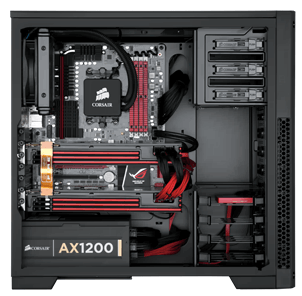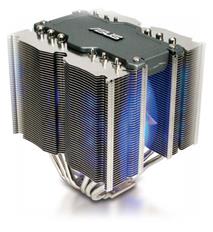What is cabinet?
Are you wondering where is cabinet?

What are the common problems faced in a cheap cabinet?
The first problem you ever face with any cheap cabinet is the failure of front USB ports. Next is the failure of the PSU that came with the cheap cabinet.
Beyond these, there are several indirect problems that may be caused by it. They are
1. Insufficient air flow, owing to cheap fans or no fans inside it
2. Mild shocks, if not earthed properly
3. Random reboots (low quality PSU)
4. Cheap build quality
5. No sufficient room for PSU wires or cables
6. No additional screws or cables
7. No support for front eSATA or USB 3.0 ports
8. No room for additional larger fans
9. No room for larger graphic cards
Some cabinets even bend, when you add heavyweight PSUs, like mine.
Why you’d invest more in cabinets?
Let us assume that a user has 25k budget. He would allocate the processor and motherboard the most part of his budget.
Yes! It’s not a bad thing.
But have you thought about an undeniable fact?
A cabinet is the one which is not needed to be changed for years, if it’s maintained well. Then why shouldn’t you invest more in that?
I’m not advising you to buy a 5k or 10k cabinet, but at least 2k to 2.5k.
What will you get in a budget branded cabinets?

1. Solid build quality
2. Lots of room for expansion
3. Latest features like front USB 3.0 ports
4. Sufficient airflow, which gives longer life for processor and graphic cards
5. Additional room for larger coolers
6. May be a separate room for PSU cables
Corsair, Cooler Master, Antec, Thermaltake are some of the good companies in cabinet manufacturing. My recommendation is Corsair Carbide 300R cabinet.
What is a cooler?
A cooler may be a CPU cooler or additional cabinet fans.
Generally processors come with a stock CPU cooler, which is of normal quality. If you want to maintain a still cooler temperature for your processor you’d go for an aftermarket cooler.
Why’d you go for an aftermarket cooler?

What is overclocking?
Normally we address the speed of the processor by clock speed.
Do you know what actually happens inside the processor?
Every processor has a base clock on which the FSB, including the RAM works. But each of them has their own multiplier and that’s why their resultant clock speed differs.
So if you increase their individual multipliers then you can change their individual clock speed.
But if you change the base clock of the processor then the total bus frequency will be increased, which will increase the resultant clock speed of all the components that are connected to the bus.
To explain this better, assume three persons A, B and C are on an escalator, which is moving at 10kmph.
- A is standing still
- B is moving at 10kmph on it. So his net speed is 10+10=20kmph
- C is moving at 30 kmph (just assume). So his net speed is 10+30=40kmph
Now if I want to change the individual net speed of C, I can raise his speed from 30 to 35kmph. Instead, if I increase the escalator speed by 5kmph, then the net speed of all, A, B and C will be increased by 5kmph.
You may ask me, isn’t that good?
Certainly not. Because your processor may overclock higher, but your RAM may not be that much efficient in overclocking. So, we should consider all these factors while overclocking.
You may also think why can’t we increase the multiplier then?
Yes you can, but only if you’re allowed to.
Confused?
Your processor manufacture should have allowed you to change it. It means you’d have bought an unlocked processor, which means unlocked multiplier.
All the FX lines of AMD processors come with unlocked multiplier, but not all of its APU line up.
So how to find that?
If your processor model number ends with ‘k’ then you have unlocked multiplier, else you don’t have. This applies to both Intel and AMD.
If you have all of these requirements, then your processor should have sufficient cooling facilities for better overclocking, else you can attain as low as 100MHz improvement only.
Last year, AMD had set a Guinness world record on processor overclocking with liquid helium cooler. Just see this video. The liquid helium is poured from pipes, which gets evaporated as soon as it’s been poured.
[videoembed type=”youtube” ratio=”sixteen_by_nine” align=”alignleft” width=”600″ url=”http://www.youtube.com/watch?v=KccZu_a8IVI” shadow=”yes” id=”video-0″]

Some of the famous brands are Cooler Master, Thermal take, Corsair, Antec etc. You can also buy liquid coolers from Rs.3500. But air cooler is more than sufficient for a normal budget user and also they last longer.
You may buy a decent cooler, not only for overclocking, but also to improve the processor life as well as to reduce the noise that comes from the smaller CPU fans.

Is overclocking possible with all types of coolers?
It’s possible with stock cooler too, but the overclocking headroom depends upon the processor and the cooling efficiency of the CPU cooler